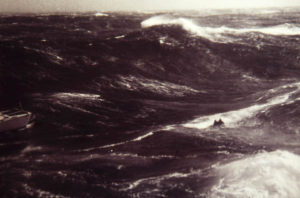
Bill and Robyn Forbes are hauled aboard the survey ship HMNZS Monowai from their disabled catamaran Ramtha on 5th June 1994
Sky the colour of old dish water, a wide halo round the sun and falling barometer. These were our first clues that the fine weather of the last few days might not last. We were on passage between Raoul island and Nuku’alofa in the Kingdom of Tonga and with 15 to 20 knot winds from the South east the ride had been comfortable and good progress was made. Forecasts from New Zealand and the Cook islands were reporting a deepening tropical low, some 300 miles to our north west, confirming my suspicions that a stronger blow was to be expected.
As the day progressed the wind backed to the east. By night fall it had strengthened considerably, though we still made good progress under double reefed main and stay-sail. Next morning, we saw no sun rise.
As darkness lifted we looked out over a seascape of large waves with long rolling breaking crests. The wind, now strong gale force and gusty was from the north east and a change of tactics was called for.
Running down wind didn’t seem like a good idea as this would take us across the path of the low pressure system so instead we lay hove to under double reefed main.
As events unfolded, proved a most effective strategy. Drifting very slowly down wind, the smooth ‘slick’ that formed to windward seemed to encourage breaking waves to loose the worst of their energy before coming too close. Below deck, the boat’s motion was not particularly uncomfortable, though from time to time a huge wave would crash against the hull like a demolition hammer, knocking the boat sideways.
And so we spent the next 4 days. Night were illuminated not by stars or moon, but from the fluorescence of breaking crests. For brief periods, measurable in seconds, the wind would drop away to almost nothing, then quickly resume with renewed vigour.
Finally, as the direction shifted from north towards the east, we felt relieved as conditions moderated to a regular gale force, and we could hoist the stay-sail and be on our way again. Thanks to a strong boat, a sturdy rig and the unburstable quality or our 9 year old main sail (Garland sails, Bristol), we suffered nothing worse than frayed nerves and were sincerely grateful. Sadly, not all that were at sea during the storm were as fortunate.

HMNZS MONOWAI approaches the disabled catamaran Ramtha in 60 knot winds and 10m seas.
New Zealand lies too far south to be regularly troubled by the cyclones that frequently cause such devastation in islands of the western Pacific. Officially the season runs from November to April but in recent times a few have been recorded in May so most visiting boats choose to return to the tropics in late May or June. As in previous seasons, adding to their numbers were boats from New Zealand’s Island Cruising Association Tonga Rally. Traditionally this is a fun event with heavy emphasis on safety rather than competitive racing and as usual included a mix of well travelled international cruisers such as Warren Brown’s WAR BABY and a few for whom this was to be their first experience of off shore sailing.
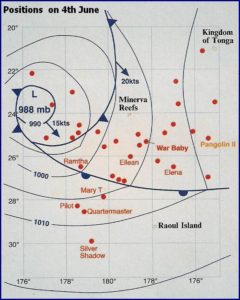
Relative positions of boats on 4th June.
On 28th of May the fleet of about 35 boats set sail for Tonga. Winds were from the south west and forecast prospects for the next few days were excellent. With a thousand miles to go, most boats expected to be at sea for at least a week; a time during which the weather could change significantly.
Warnings of the approaching low started arriving on 2nd and 3rd of June but since it was expanding and moving faster than the boats could travel, there was little anyone could do to avoid it. At 0000 UT on 4th June, it was located at 25S and 175E and at about this time, the Marine Rescue Centre in New Zealand began receiving signals from Emergency Position Indicating Beacons (EPIRBs)
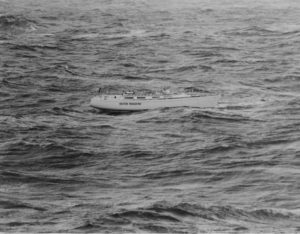
The disabled yacht SILVER SHADOW during rescue operations on 6th June
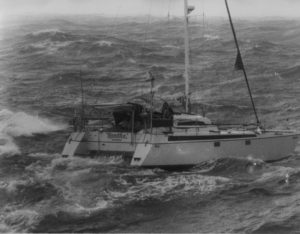
Catamaran RAMTHA

HMNZS MONAWAI’s RIB alongside after the rescue of Peter O’Niel from the yacht SILVER SHADOW on 6th June
A RNZAF Orion search aircraft was dispatched to the area and so began what is believed to be New Zealand’s largest marine rescue operation. 7 yachts abandoned, 20 people rescued and 1 lost with all three crew members.
One ship in the area was the 3500 ton New Zealand Navy survey vessel HMNZS MONOWAI; on route between Raoul island and Tonga. The crew though they were doing a fine job skirting round the bad weather but then at 0030 UT. they were called a call to divert to the south west where the wooden yawl MARY T was in serious difficulties. The rudder had bent the propeller, putting both parts out of action and the boat was filling with water from an unidentified leak.
MONOWAI made best speed towards MARY T but with wind and seas abeam was rolling heavily and deck edges were frequently underwater. Even for a ship of this size, sea conditions were a serious cause for concern.
WHO FIRED THAT FLARE?
At 16:21 UT the officer of the watch reported what appeared to be a white flare. Curiously, it didn’t seem quite like a normal flare and nothing could be seen either visually or on radar. However a call was put out on channel 16 requesting any vessel firing a white flare to make contact.
This soon brought a call from the Australian catamaran RAMTHA crewed by Bill and Robyn Forbes. They had also seen the flare and reported it as white turning green then orange. Their mainsail had blown out, auto pilot was not functioning and they were having a difficult time, but were not in immediate danger.
A short time later this situation took a turn for the worse as a large wave destroyed their hand steering mechanism and with no means of control the boat rolled heavily. Because the risk of capsize had become a strong possibility they decided to abandon the boat and called MONOWAI again.
A while later, the breaking dawn revealed a horrendous picture with seas running at about 10 metres, winds around 55 knots gusting to 70 (occasionally more) and rain squalls. MONOWAI was rolling to around 35 each way, which for a yacht is no great deal, but the ship’s stability characteristics allowed for little more. Clearly to come along side RAMTHA would have risked crushing her so taking the crew off safely was going to be a difficult operation.
In outline, the chosen plan was for MONOWAI to approach as close as possible, and with the aid of rocket or gun lines, to establish a connection through which a stronger line could be passed. Wearing wet suits, life jackets and safety harnesses, the crew of RAMTHA would then be drawn through the water and hauled aboard.
In practice, close manoeuvring proved extremely difficult and when within range, the two vessels would quickly drift apart. Several shots were needed to establish a connection and there was little time to exchange the civilised system of prearranged signals to indicate when MONOWAI were prepared for hauling and that RAMTHA’S crew were ready at their end.
As things worked out, no sooner had Robyn and Bill Forbes clipped on the harnesses, than the two vessels rolled apart and they were jerked off their feet into the sea.Fortunately, no injuries occurred and on MONOWAI the fo’c’sle hauling party responded quickly to the difficulties, giving and taking slack as necessary. After a short time the first Forbes family (by strange co-incidence the second crew rescued by MONOWAI was also named Forbes) was hauled safely aboard the ship.
During these events, and those of the following days, RNZAF aircraft flew continuously, searching sea areas affected by the storm, and playing a vital role in monitoring the situation aboard yachts who were not in immediate danger but none the less experiencing difficulties. Yachts such as 12m sloop TAKI MOANA where Michael and Jenny Gray were dealing with a flooded engine, electrical fire and sea sickness.
The yacht PILOT was another, clearly in bad shape having lost the mast during a 360 roll. The mast had fractured in several places but as Greg and Barbara Forbes cleared away the debris they found that the damage was not due to rigging failure as all stainless parts remained intact.
With no mast the boats motion was jerky and violently. An engine problem added to their difficulties and after almost 2 days of hand steering and being tossed and battered by heavy seas, they were both exhausted and decided to abandon to abandon the boat.
Visibility was restricted by large waves and rain and spray occasionally made brilliant low level rainbows. It was through one of these that PILOT’s crew first spotted MONOWAI – heading slowly towards them. At On 5/June at 2115 UT, the second Forbes family were hoisted safely aboard
Directed by Orion search aircraft, MONOWAI was next dispatched to the yacht SILVER SHADOW some 50 miles to the south west and with 4 people aboard some. Like PILOT, it had also been dismasted following a 360 roll but in the process the skipper, Peter O’Neil, had received a broken shoulder.
In spite of being under emergency steering they were able to make slow progress under engine and made contact with MONOWAI shortly before nightfall.
Clearly with their skippers injuries, a RAMTHA style transfer was not possible. and though winds had moderated a little, conditions for deployment of MONOWAI’s rigid inflatable (RHIB) were decidedly marginal. However it was launched successfully and SHADOW’s crew, with stretcher bound skipper, were brought to the leeward side of the ship. All were hoisted aboard safely but at one stage the boat was swamped by a large wave and its engine began putting out black smoke. Retrieving the RHIB also proved a most difficult operation, as MONOWAI rolled heavily and the boat occasionally struck the ship’s side.
FRENCH NAVY AND CARGO SHIP RESCUES
At the Marine Rescue Centre in Auckland, rescue co-ordinators faced repeated dilemmas. It was impossible to know from where the next call for help might come. When was it right to divert a aircraft from monitoring a yacht in difficulties, to check out a new EPIRB signal? With so many yachts in similar trouble, resources were stretched to the limit.
One of the first EPIRB calls came from the yacht DESTINY. It had been pitchpoled, the mast collapsed and skipper Dana Dinius’s leg had been broken. The boat was taking water and Paula Dinius, bailed water and tried to clear away dangling rigging parts that threatened to puncture the hull. After hours of pain and bailing, they were rescued by the Fijian cargo vessel TUI KAKAU III.
The yacht SOFIA with Keith Levy and Ursula Schmidt aboard, had also been rolled and dismasted. The main radio had been destroyed by sea water though with the aid of a hand held, they were still able to communicate with an Orion search aircraft. They were eventually picked up by the French navy landing craft Jaques Cartier, and taken to Auckland.
Aboard WAIKIWI II, Katherine Gilmour, one of the crew of 5, got to use a present her father had given her shortly before he died. It was an EPIRB. After being rolled twice WAIKIWI’s mast collapsed, breaking in several places. The life raft was missing, water poured through broken windows and communications and navigational equipment were out of action. Thanks to the EPIRB they were located by an Orion aircraft who passed their position to the 35000 ton Norwegan cargo ship, Nomadic Dutchess, that later picked them up. As I write this article some 2 weeks later they are still at sea – enjoying an unexpected trip to Panama.
THE SEARCH CONTINUES
Between the 5th and 8th or June MONOWAI with its Wasp helicopter (Budgie), were engaged in searching a large area for the missing sloop Quartermaster. At one time some yacht and personal gear was spotted, but a pharmaceutical label identified it as belonging to the catamaran HEART LIGHT. HEART LIGHT had broken up a day or so earlier after the crew or 3 had been taken aboard the New Zealand fishing boat SAN TE MARU 18.
Apart from a life raft containing an activated EPIRB, no remains of Quartermaster were found and at 1700 on 8/June the search was officially called off.
WHAT BECAME OF THE MARY T?
In the early stages of the storm it seemed that the MARY T might not remain afloat, but here story is one of triumph. The water leak was eventually traced to the extra heavy seas that were flooding the cockpit. Some was finding its way through locker lids and gaps in hatch boards, but once the problem was understood a solution could be found. Duct tape (strong wide self adhesive tape) provided the answer. With the gaps sealed and the boat pumped out, leaks were no longer a problem. Later as conditions subsided the wind vane was pressed in to service as an emergency rudder and slowly, slowly MARY T made it to Fiji, her original destination
EVOLUTION OF A STORM
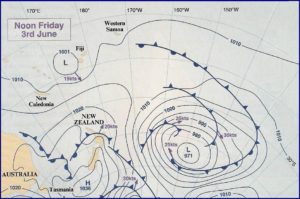
The weather system that was to become the storm first appeared on surface analysis charts as a small shallow area of low pressure between Vanuatu and Fiji.
It began moving south and in the process attracted cold Antarctic air from a high pressure area already well established over New Zealand – the high pressure that had earlier given such good weather to boats leaving. This caused it to deepen rapidly and the central pressure fell 10hPa in 24 hours.
It’s effects were not easy to predict. “Since the pressures remained high on the South side of the depression, isobars there were compressed together into a squashed zone of accelerating wind.” says Bob McDavitt of MetService. Because of the high pressure holding on it at the South it can be difficult for anyone in the path of the approaching low to detect it’s approach simply by watching the barometer. The vigorous winds come before the barometric warning!” At 979hPa on 5th June the system was at its peak, although by this time more Northerly boats were reporting that wind and sea conditions had started to moderate.
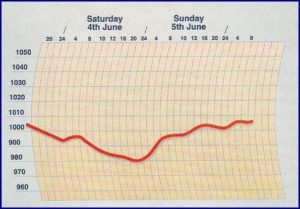
The following day, its movement was more South Easterly, but by now it had expanded bringing 60 knot winds within 100 miles and 40 knots within 300 miles of the north eastern semi circle. Later winds up to gale force were forecast for areas within 900 miles. At 36 south, its movement was more easterly as it began following the usual route of winter depressions that regularly travel these latitudes. Was the June storm a freak?
It would seem not. Bob McDavitt, Northern Forecast Manager for MetService New Zealand, describes such a cold/warm air clash as a “bomb”. Similar events can occur in any ocean, In the south Pacific, about 3 to 4 occur each year though generally between 30 and 35 south, but they may occur in any ocean and at any time of year.
HEAVY WEATHER TACTICS
Most boats carry at least some heavy weather gear, though fortunately for most of us, opportunities to try it out in earnest are rare. In the June storm, strategies can be broadly divided into two depending on whether the boat concerned was in the ‘navigable’ or ‘dangerous’ semicircle of the weather system. (in this case to the south west or north east)
In the navigable section, the crew of ‘St.Leger’ decided to run down wind with little or no sail. The boat’s speed was reduced by trailing a 48″ Gale Rider drogue astern. To optimise the length of the tether line needed adjusting to suit the wave patter n. Eventually 48′ seemed about right and with wind vane steering little attention was needed over a 60 hour period with winds gusting to 60 knots..
As the majority of boats were in the dangerous semicircle, the technique of running with wind and seas astern was less appropriate. Such a course would take them in the direction in which the system was moving and possibly closer to its centre. Instead many opted to heave to or to take all sail down and lie ahull under bare poles.
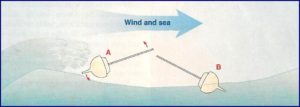
The EILEAN, a 53′ ketch of 40 tons displacement, experienced difficulties in heaving to as their hydraulic steering system made it impossible to lock the rudder position. The problem was partially solved by using the electric autopilot to maintain hydraulic pressure. This in turn meant running the engine to keep batteries toped up, but by driving ahead slowly, slight progress was made to windward. Heavy seas regularly broke on deck – one smashing an armoured glass window, though a thick polycarbonate storm board prevented serious leakage.
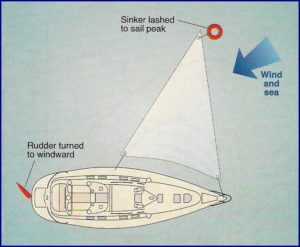
In a similar position, the smaller Swiss Cutter ELENA, crewed by Guido and Yvonne Borsani, was also hove to, at first under triple reefed main and staysail. As conditions worsened
this was progressively reduced to main plus storm jib, storm jib only, then bare poles. With the tiller turned to windward and the wind at about 75 off the bow, for most of the time the boat seemed to ride the conditions well, but an incident occurred which that brought home to the Borsanis the danger of their situation. Heeled hard to leeward near the top of a wave, the boat was once struck amidships by a heavy breaking crest. It was simultaneously pitched into a windless trough and violently heeled in the opposite direction. (see Fig 2) Technically this was probably not a ‘knock down’ and its effects, though not disastrous certainly gave cause for serious concern. Yvonne, lying in the leeward bunk, had been hurled some 2 metres across the main cabin, miraculously suffering only severe bruising. The engine was out of service, as water had been forced through the siphon breaker, water trap and had filled one or more cylinders. On deck, all standing rigging had become mysteriously slack, though nothing appeared to have broken.
To reduce the risk of a repeat performance Guido adopted the unconventional tactic of trailing a head sail in the sea as a side drogue. A car tyre lashed to the peak acted as a light sinker, the tack was secured to the bow and the clew lashed amidships. In such strong winds, deploying (and retrieving) the arrangement was no easy task, but once set it helped slowed their sideways drift and more important, it appeared to absorb some energy from breaking seas.
CONCLUSIONS
The main value in studying storm tactics is to extend ones repertoire of ideas that might be tried in similar circumstances. In the June storm the most popular strategy was to heave to. Some boats, particularly those with long keels, can do this more easily than others and often a little trial and error is needed to establish the optimum set up of sails and rudder. Clearly, boats that had worked this out before the storm struck were at an advantage.
Both air crews and MONOWAI reported the extreme difficulty of spotting white hulled boats in a background of breaking seas, especially those that were dismasted. Physiologically, the human visual system is adapted to respond to hard edges, like the mast that breaks the background of mainly horizontal waves and horizon. So if you can’t face the idea of a bright orange boat, why not carry a sectional fiberglass pole (fishing rod?) and large square of orange material to use as a flag for the odd occasion when your really need to be noticed?
In locating boats, the single most effective piece of equipment was the 406Mhz EPIRB. By referring to registration details provided by 406 purchasers, rescue co-ordinators could provide search aircraft with a detailed description of the craft they were looking for. 121.5/243Mhz types were also used to good effect but lacked this useful facility
Finally, following the experiences of the MARY T, I must remember to include waterproof sticky tape as an essential part of the PANGOLIN II repair kit.
ACKNOWLEDGEMENTS.
In preparing this article, I am most grateful for the extensive help I have received from :
Crews of yachts affected by the storm.
Master and Crew of HMRNZ Monowai.
Bob McDavitt – MetService NewZealand.
Don Mundell – New Zealand Island Cruising Association
HMNZS MONOWAI BLACK & WHITE PHOTOGRAPHS
Crown Copyright. HMNZS MONOWAI
Photographer: CPOAHS Geoffrey Marshall